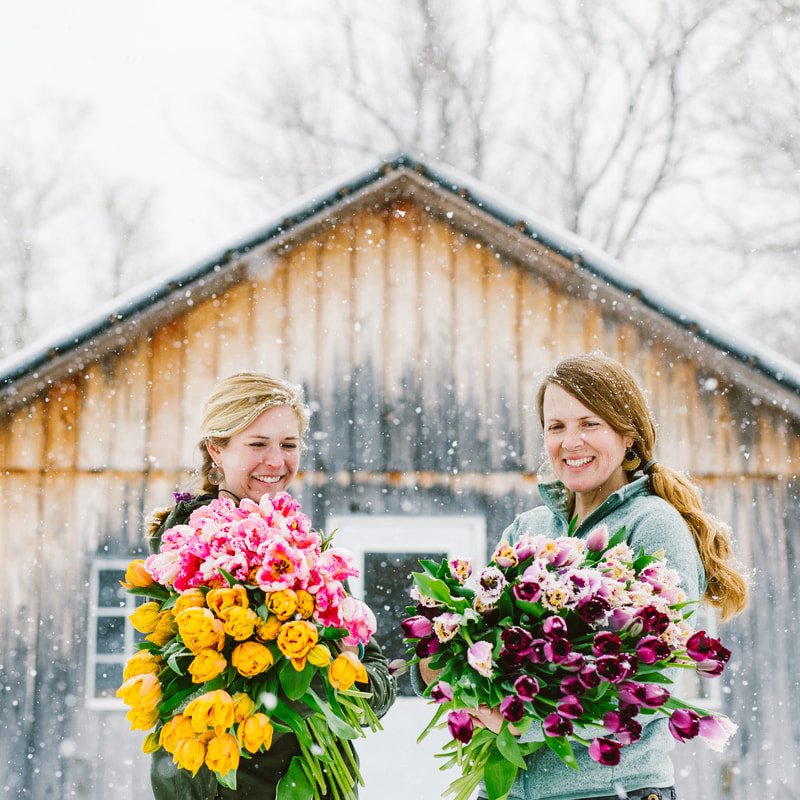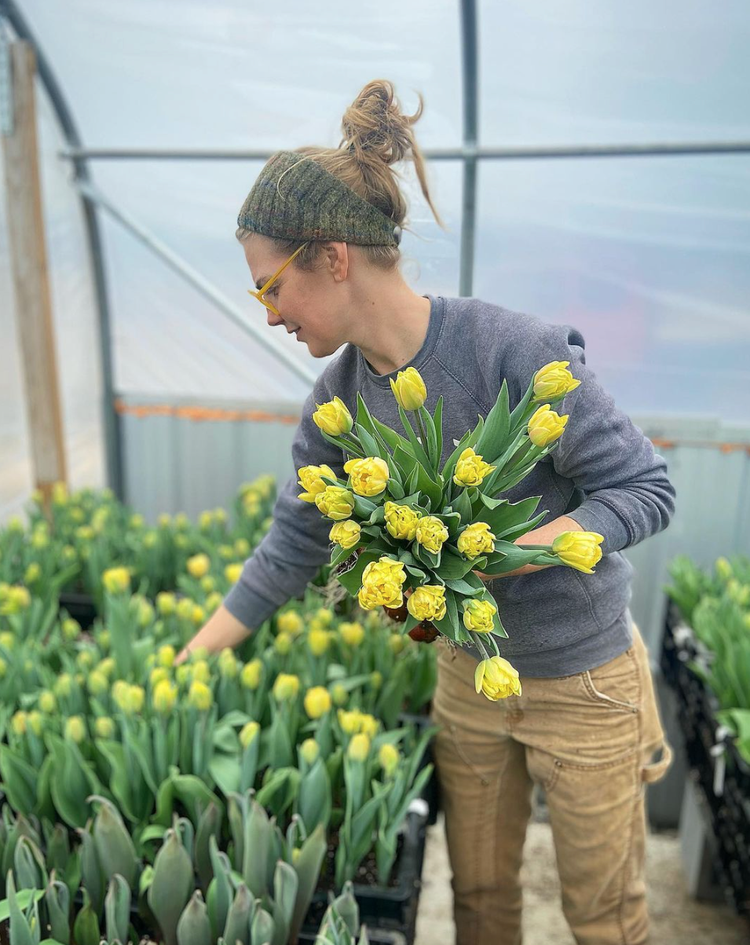Above: The ‘Silver Parrot’ Tulip from Little Farmhouse Flowers, upon arrival. Tulips are picked right when their heads begin to show color.
This week we kick off our second annual February Specialty Tulip Subscription, and in case anyone out there wants more of the backstory on why and how we’re sourcing tulips locally, this post is for you!
I think I really SAW Tulips for the first time in February 2021. I’d come across a video online of stunning, truly otherworldly, bright and colorful tulips growing in a very northern, wintry New York State greenhouse. The farmer, who I’d come to know was Linda D’Arco (now a bona fide winter tulip ambassador), was explaining how she was managing to cut gorgeous flowers in the middle of winter.
I soon ordered a bunch of her ‘Silver Parrot’ tulips off her website, eager to meet them in person and see if they could possibly make a great new flower for Valentine’s Day bouquets. When they arrived, they were small, closed pretty tight… to my untrained and unexperienced eye, they didn’t look like much. (See above).
Watching them unfurl over the next few days to week reminded me of the tiny green and purple plastic capsules I could add to my childhood baths: they’d suddenly burst open and become fanciful sponges. Does anyone remember those?? That was more or less akin to the experience of giving my overnighted tulips a fresh cut, and placing them in water. Not quite so immediate a change, but equally WOW.
Linda was working on becoming a winter tulip farmer and educator. Several years earlier, she’d crossed paths with Emily von Trapp, a Vermont flower farmer and pioneer of sorts in US based winter tulip forcing. They were now growing and wholesaling thousands of tulips as early as January, and also co-leading a virtual + in-person training for other flower farmers looking to extend their growing seasons and increase annual revenue, called “The Tulip Workshop.”
Below: The ‘Silver Parrot’ a few days later. And, Linda D’Arco (left) and Emily von Trapp (right).


I continued dreaming about those magical Silver Parrot tulips all year.
In late fall ‘21, a Philly-based flower farmer I had newly connected with, Cassie Plummer, reached out to let me know she was planning to invest in a LARGE order of tulip bulbs to force in her husband’s warehouse, located adjacent to her outdoor growing plot. She wondered if I’d be interested in offering some as a subscription.
YES, I answered, with zero hesitation. I wanted to take a leap and see if other New Yorkers would fall for these unusual beauties. I planned to set up our first February specialty tulip subscription that winter.
It just so happens that Cassie was a recent graduate of The Tulip Workshop! She configured an indoor growing space in the warehouse adjacent to her 1/2 acre urban farm; a warehouse her husband ran his mental fabrication business from.
Below: Jig-Bee Farm’s outdoor – and indoor – growing spaces:


Last year, Cassie and I both learned a lot about tulips. There is a true science that goes into their timed and temperature controlled production and harvests. In this corner of the globe, we’re in the learning phase. Whenever a grower takes on a new variety – let alone a new crop like winter-grown tulips – it’ll take at least a few years to perfect it – and even then, there is so much you can’t predict…
I’m so thrilled (really, the whole team is thrilled) that many of you are returning to support our 2nd annual tulip subscription. Our farmers are also thrilled, as they continue taking the leap of increasing their bulb orders (von Trapp purchased a staggering 100,000 this year!)
Below, a February ‘22 bouquet (left), and a new variety I fell in love with, ‘Pink Star.’


This year, we’re partnering with Luke Franco and Jenny Elliott, the husband-wife team that founded and run Tiny Hearts Farm in Copake, NY. And unsurprisingly, Jenny ALSO took Emily’s + Linda’s Tulip Workshop course! They are really spawning a new industry here in the US – it’s exciting!
Below left, their main farm field recently captured — frozen cover crop blanketing their carefully tended soil. Below right, their new “Bulbodome,” where they’re growing 10s of thousands of tulips this year.


The vast majority of tulips in the world are grown in the Netherlands. And while a dozen of these Dutch tulips can be found at Trader Joe’s for under $6 pre-pandemic, we never know in what working conditions they were produced, or at what expense to the surrounding ecosystem.
Side Bar / Flower Sustainability 101:
We used to have a much more robust domestic flower industry, spanning the county. However, flower growing largely moved abroad in the 1960s to 90s, as quick, temperature-controlled air travel became more affordable and commonplace. American / European cut flower moguls quickly mobilized to capitalize on more ideal growing conditions in Colombia, Ecuador and other countries, as well as more lax labor rights and environmental policies (or lack thereof).The majority of people hired to plant, cut, sort, and pack cut flowers in flower farms overseas are women of color, paid a fraction of the minimum hourly wage Americans earn. Even here, where the American-grown tulip wholesales to me for 1.35 – $1.75/stem, tulip growing is still often breakeven endeavor due to higher costs of production compared to other flowers, unless growers scale into the tens of thousands. (Bulbs are still largely sold by European conglomerates, and they’re expensive to store and ship).
Buying local of course doesn’t always guarantee transparency, organic growing methods or fair wages. However, we certainly prioritize partnership with growers who have holistic sense of sustainability: the ecological health as well as the social/emotional/physical wellbeing of their employees. When your tulips are coming from 119 miles away as opposed to thousands, it is easier to visit a farm, get to know the farmer, witness their operations, and build a trusting and fruitful relationship.
Over the past 2 years, I’ve been introduced to some incredible varieties of Tulips – a far cry from the plain, single petal versions in plan easter egg colors we tend to see in our corner stores and supermarkets — even local florists’ shops.
“Specialty” refers to a dozen or so classes of Tulips organized by their unusual petal shapes and petal counts. There are Parrots, Doubles, Peony types, French, Lily-flowered, Viridiflora tulips, Greigii, Fosteriana and Fringed tulips – among others. And within each of these categories, there are many, many varieties.
Below: ‘Vase of Flowers,’ (Jan Davidsz. de Heem, 1660) is one of the most famous paintings of flowers to come out of the Dutch Golden Age. Notice the pair of red and white Parrot tulips jumping out, middle right!

To force Tulips indoors, bulbs are planted in crates, and sprouted in an indoor space, or a passively heated greenhouse. The ideal sprouting temperature is just around 50-60 degrees. In Cassie’s warehouse, a space heater was turned on occasionally. Once bulbs have sprouted, the tulips are grown on at 60-62 degrees until they’re ready for harvest.
In an outdoor, mostly passively heated greenhouse or ‘Bulbodome,’ sunny days warm the structure up; heat is used when temps drop too low.
So, even if you’re working with 3 degree weather (That’s the temperature in Jay, NY as I write this), a sunlit greenhouse along with some supplemental heat overnight when the sun isn’t out is just about perfect for growing tulips.
I’m really looking forward to continuing to witness and support these growers in their quest to build back a local flower industry, crop by crop.
Thank you for joining me in that endeavor! The reward is so. much. beauty. And hopefully for generations to come.
Below:
The indoor Jig-Bee growing room; Jenny of Tiny Hearts Farm picking tulips in the Bulbodome last winter; and, a staging of this week’s tulips for their portrait sessions.



